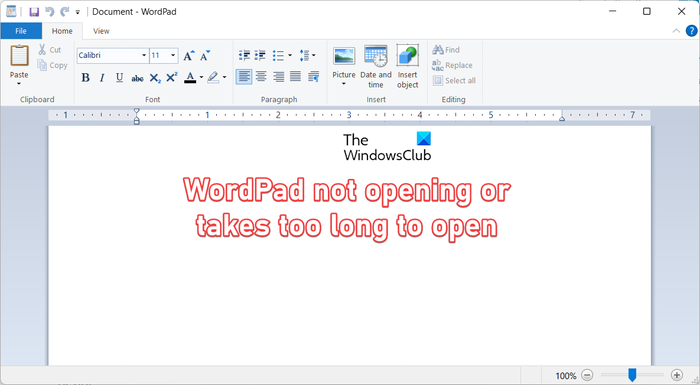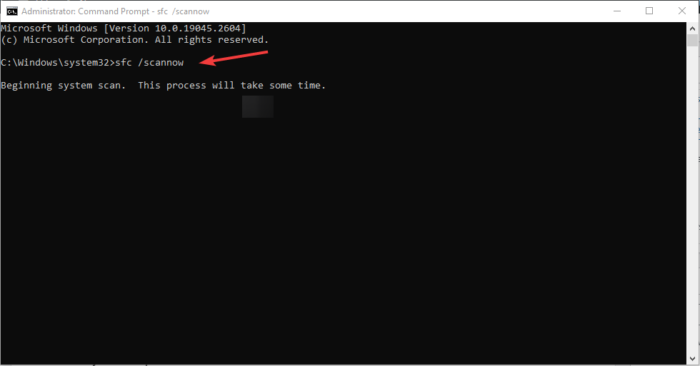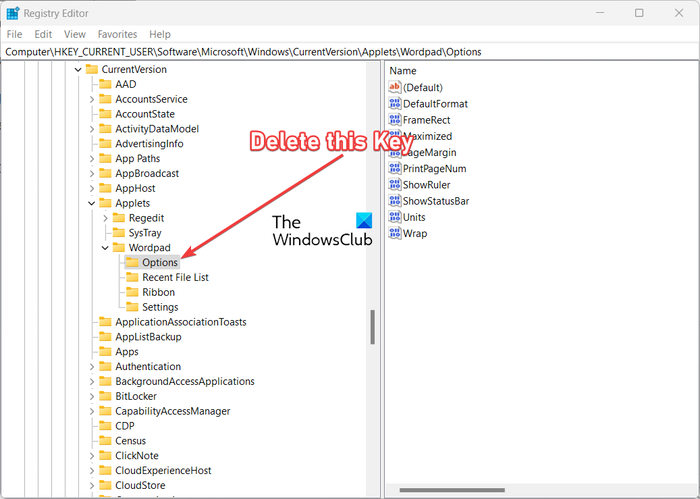If WordPad takes too long to open or just won’t open on your Windows PC, this guide will help you fix the issue.

Why is my WordPad file not opening?
If your WordPad app is not opening, it might be due to different reasons. Some potential causes of this problem include broken or missing system files, malware infection, and corrupted user preferences or other data in WordPad.
WordPad takes a long time to open or not opening
If WordPad is not opening on your Windows PC or if it takes too long to open, here are the methods you can use to fix the problem:
- Open WordPad directly from the installation folder.
- Run an SFC scan.
- Scan your system for malware.
- Reset WordPad using Registry Editor.
- Uninstall and Reinstall WordPad
- Use an alternative to WordPad.
- Disable & re-enable network adapter.
1] Open WordPad directly from the installation folder
The first thing you can do when WordPad is not opening or is taking too long is to run the app directly from its installation folder. You can open WordPad’s installation directory and run the wordpad.exe file with administrator privileges. Let us check out the step-by-step procedure to do that:
First, open File Explorer using Win+E and navigate to the directory where the main executable of WordPad is present. It is available at the below location:
C:\Program Files (x86)\Windows NT\Accessories

Next, right-click on the wordpad.exe file, and from the appeared context menu, choose the Run as administrator option.
After that, click Yes on the UAC prompt and see if the WordPad app is opening correctly or not.
In case the issue remains the same, move on to the next fix to resolve it.
2] Run an SFC scan

It could be a corrupted or missing system file causing the issue. Hence, if the scenario is applicable, you can use Windows’ built-in command-line utility called System File Checker (SFC) to fix the damaged system files. Here is the command that you need to use to perform an SFC scan.
First, open the Command Prompt with administrator rights and enter the below command:
sfc /scannow
When the command is finished, reboot your computer and then check if the issue is resolved.
3] Scan your system for malware
This issue could be caused if your computer is infected with a virus or malware. Hence, you can run a virus scan on your computer and remove potential threats from your PC. After that, open WordPad and check if the issue is resolved.
4] Reset WordPad using Registry Editor

If the problem still persists, you can try resetting the WordPad app to its default settings. It might be some corrupted user data and preferences associated with WordPad causing the issue. So, in that case, you can reset WordPad and see if the issue is resolved.
To do that, you need to use Registry Editor and make some modifications to it. However, before doing that, it is highly recommended to create a backup of your Registry as any incorrect tweak can cause severe damage to your PC.
Now, you can follow the below steps to reset WordPad:
First, open Run using Win+R and enter regedit in its Open box to quickly open the Registry Editor app.
Next, move to the following address in the address bar:
HKEY_CURRENT_USER\SOFTWARE\Microsoft\Windows\CurrentVersion\Applets\Wordpad\
Now, right-click on the Options key at the above location and choose the Delete option from the appeared context menu to delete the key.
Once done, close Registry Editor and reboot your computer. On the next startup, try opening WordPad and see if the problem is resolved or not.
5] How to Uninstall and Reinstall Microsoft WordPad
You can Uninstall and Reinstall WordPad
6] Use an alternative to WordPad
Well, if you are still unable to fix the problem, you can use an alternative to WordPad to create text documents. There are several free word processors that you can use in place of WordPad, e.g., LibreOffice, OpenOffice, Microsoft Word, FocusWriter, and more. If you want to create plain text documents, Notepad is the best option.
7] Disable & re-enable network adapter
While researching this issue, we found that for some reason, some affected users have reported being able to open WordPad quickly after disabling their network adapter. There is no explanation for why this works, but you can try this hotfix and check if it helps you.
You can open Device Manager from the Win+X menu, expand the Network adapters menu, right-click on your network adapter, and choose the Disable device option. After that, try opening WordPad and see if the issue is resolved. You can later enable the network adapter device to go online and connect to the internet.
Hope this helps!
Related: Fix WordPad is missing.
What to do if WordPad is not responding?
If WordPad is unresponsive or keeps crashing or freezing, you can try resetting the WordPad app to its default settings. Besides that, fix the corrupted system files or try removing malware from your computer to fix the problem.
Now read: Microsoft Word keeps crashing on Windows.
Leave a Reply